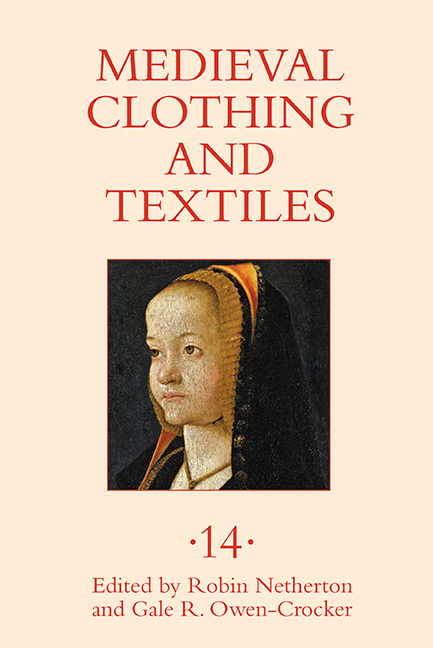Book contents
- Frontmatter
- Contents
- Illustrations page
- Tables
- Contributors
- Preface
- 1 Multicultural Clothing in Sixth-Century Ravenna
- 2 Byzantine and Oriental Silks in Denmark, 800–1200
- 3 The Bliaut: An Examination of the Evidence in French Literary Sources
- 4 Eyebrows, Hairlines, and “Hairs Less in Sight”: Female Depilation in Late Medieval Europe
- 5 Lexical Exchange with Italian in the Textile and Wool Trades in the Thirteenth to Fifteenth Centuries
- 6 Hidden in Plain Black: The Secrets of the French Hood
- Recent Books of Interest
- Contents of Previous Volumes
6 - Hidden in Plain Black: The Secrets of the French Hood
Published online by Cambridge University Press: 13 July 2019
- Frontmatter
- Contents
- Illustrations page
- Tables
- Contributors
- Preface
- 1 Multicultural Clothing in Sixth-Century Ravenna
- 2 Byzantine and Oriental Silks in Denmark, 800–1200
- 3 The Bliaut: An Examination of the Evidence in French Literary Sources
- 4 Eyebrows, Hairlines, and “Hairs Less in Sight”: Female Depilation in Late Medieval Europe
- 5 Lexical Exchange with Italian in the Textile and Wool Trades in the Thirteenth to Fifteenth Centuries
- 6 Hidden in Plain Black: The Secrets of the French Hood
- Recent Books of Interest
- Contents of Previous Volumes
Summary
A desire to establish a timeline for fashion details in sixteenth-century England led this author into a close study of portraits from that period. Accurate dating of portraits can be a difficult task. The portraits rarely include a specific year as an inscription. Some portraits have an inscription of the sitter's name and perhaps an age as well, and personal records can sometimes provide the dates of occasions when the sitter would have been likely to have a portrait painted. Some portraits carry the name of the artist, so the time frame can be narrowed down to the period when this artist was active. Sometimes, however, a portrait depicts an unidentified sitter painted by an unidentified artist, or different dates are suggested for the same painting by different sources. In order to compensate for this, the author set out to build a reasonably reliable timeline by comparing only headdress and hairstyle, as these two fashion elements are more easily changed overnight than a whole dress. This comparison led straight into the minute study of the French hood and its many variants over time and location and resulted in a set of theories regarding the construction of the French hood, the timeline of the French hood, and the evolution and purpose of the feature known as the bongrace.
Other attempts to reconstruct a French hood have been published in recent years by Ninya Mikhaila and Jane Malcolm-Davies in The Tudor Tailor and Sarah Lorraine in “Reconstructing the French Hood,” but the results do not to this author look much like the iconic headdress associated with the reigns of Henry VIII, Edward VI, Jane Grey (for nine days), Mary I, and Elizabeth I.
The research material used for this study includes not only paintings and drawings of the English headdresses but also depictions of the hoods worn in France. A major difference between finished paintings and preparatory drawings is color. In a painting, the artist would portray the colors of the goldsmith's work, set in two curved lines on either side of a crescent shape (usually either white or red), and he would define the visible parts of the oreillette (the coif covering the ears; see detailed discussion below), but the rest of the French hood is black and frequently set on a very dark background.
- Type
- Chapter
- Information
- Medieval Clothing and TextilesVolume 14, pp. 141 - 178Publisher: Boydell & BrewerPrint publication year: 2018



